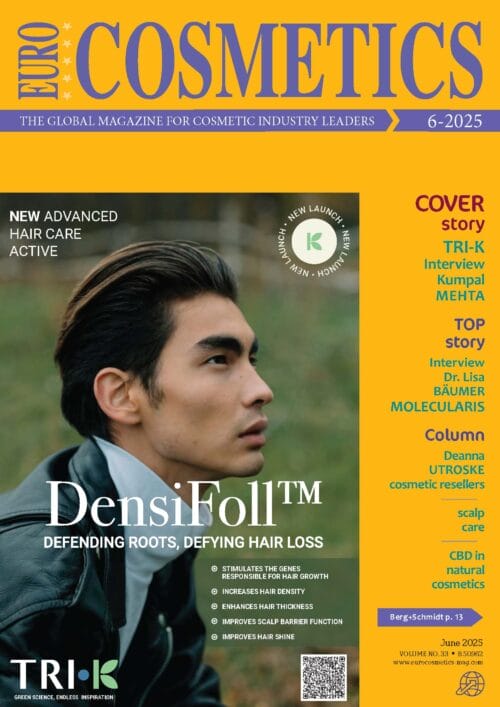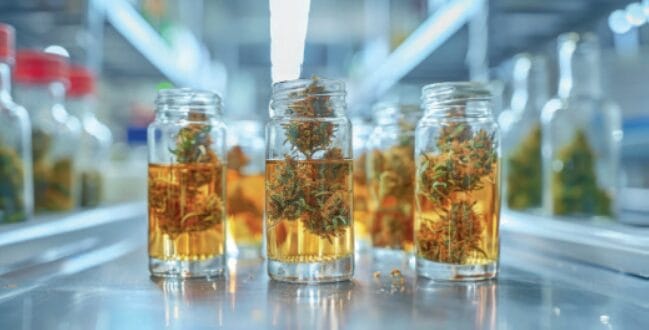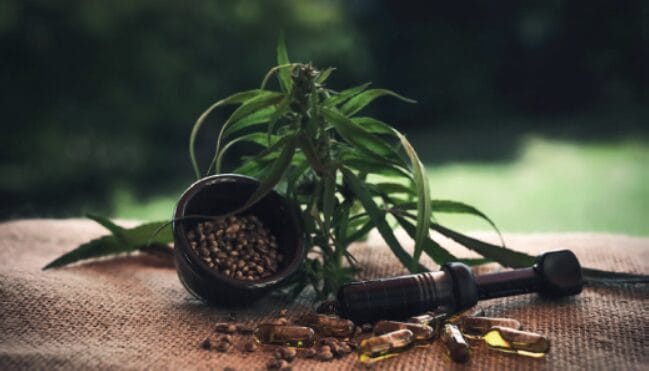
A versatile, sustainable but controversial substance
Cannabidiol (CBD) has rapidly become a focal point of consumer and regulatory interest. The botanical origin, Cannabis sativa L. can be cultivatedsustainably, acts as a carbon sink, supports soil regeneration and can be certified as organic. Given that effectively the entire plant – stalks, seeds, flowers and leaves – can be harvested and processed, hemp is a multipurpose, versatile crop used to make biobased products for various sectors including cosmetics, food, feed and textiles. In the European Union (EU) “hemp” (Cannabis sativa L.) is authorised under Regulation (EU) No 1308/2013[1] allowing for industrial production from 75 varieties with THC content of less than 0.2% by law.
CBD is one of the approximately hundred naturally occurring cannabinoids found in Cannabis plants and may account for up to 40 % of the plant’s extract[2]. CBD can be synthesised from petrochemical moieties or extracted from the leaves of Cannabis sativa L. as an isolate using supercritical carbon dioxide. In cosmetics it can function as active due to its antioxidant, anti-sebum, and skin conditioning properties. However, while substances such as Cannabis sativa (hemp) Seed Oil have a long-term use and acceptance as an emollient in natural cosmetics skincare, CBD has faced greater regulatory scrutiny. Across the European Union (EU), as of 2025, on-going reviews for cosmetics, divergent actions by Member States, and a new wave of regulatory developments is poised to shape the ingredient’s future. Outside the EU, in China, the National Medical Products Association (NMPA) banned cannabidiol, cannabis sativa fruit, cannabis sativa oil and cannabis sativa leaf extract in May 2021.
Clarifying the Cannabis – CBD connection
According to the World Health Organization (WHO), CBD is a non-psychoactive cannabinoid with no abuse or dependence potential[3]. In EU law, an underlying principle of the Cosmetics Regulation (EC) 1223/2009[4] (EU CPR) is that products must be safe for human health. To this end, cosmetic products shall not contain substances prohibited by law that are listed in Annex II of the EU CPR. Inspection of the entry 306 of Annex II indicates reference to ‘Narcotics, natural and synthetic: All substances listed in Tables I and II of the Single Convention on narcotic drugs of 1961’ for various substances derived from Cannabis sativa. The 1961 Convention[5] provided a definition for a ‘drug’ as any substance in Schedules I and II, whether natural or synthetic. Schedule I lists cannabis, cannabis resin and extracts, and tinctures of cannabis, but CBD was never explicitly included in the Schedules of the 1961 Convention. Consequently, CBD could be considered outside the scope of the Annex II entry to the EU CPR, except if it is prepared from a
substance listed in Schedule I where CBD would under the scope of the 1961 Convention and trigger a prohibition for cosmetics.
To give added legal weight to the argument that CBD is not a narcotic, in November 2020, the CJEU judgment in Case C-663/18[6] concluded that CBD should not be considered as a drug under the 1961 Convention. This judgement equally covered cases where CBD is a cannabis extract, since, according to the CJEU, CBD ‘does not appear to have any recognised psychoactive effects in the current state of scientific knowledge’. The CJEU whilst acknowledged that extraction would lead to variable THC content, but this would not exceed 0.2%. Considering this judgement, it became clear that clarification on the use of CBD was required for various sectors, including cosmetics. To this end, where CBD would not be covered by entry 306 of Annex II of the EU CPR, then it would not be de facto prohibited meaning that the use of CBD in cosmetics would be allowed provided that the provisions in Article 3 of the EU CPR. Nevertheless, as per Article 17 of the EU CPR, the presence of the psychoactive tetrahydrocannabinol (THC), as an unintended but equally prohibited substance, required addressing for its safety and the profile of CBD overall.
In 2022, the non-legally binding Cosmetic Ingredients Database (CosIng[7]) from the EU Commission, were revised to modify the status of CBD by removing the reference to entry 306 from Annex II of the EU CPR. This placed CBD (natural or synthetic) with the same status as Cannabis sativa (hemp) Seed Oil and other hemp extracts or derivatives. However, an important distinguishing factor remained in that different part of the plant could influence whether the substance fell within the definition of ‘cannabis’ set out in the 1961 Convention. Concretely, seeds, leaves, root, stem, calluses and sprouts not accompanied by the tops would be out of scope, but flower or leaves with tops where the resin has been extracted could qualify as in scope of the Convention (i.e., as ‘drugs’) except if they would come from industrial crops where the THC level is low – as in the EU.
[1] https://eur-lex.europa.eu/eli/reg/2013/1308/oj/eng
[2] https://health.ec.europa.eu/document/download/e25c55c6-be05-4875-8a0e-56fd1f4f5409_en?filename=sccs2022_q_036.pdf
[3] https://www.who.int/news-room/questions-and-answers/item/cannabidiol-(compound-of-cannabis)
[4] https://eur-lex.europa.eu/legal-content/EN/ALL/?uri=celex%3A32009R1223
[5] https://www.unodc.org/unodc/en/treaties/single-convention.html
[6] https://curia.europa.eu/juris/liste.jsf?language=en&td=ALL&num=C-663/18
[7] https://ec.europa.eu/growth/tools-databases/cosing/
Safety Assessment
Changes to CosIng prompted the needs to evaluate the safety of CBD for cosmetics. Therefore, in June 2023, the European Commission (EC) opened a call for evidence for CBD as a preliminary step to an independent risk assessment of the substance by the Scientific Committee on Consumer Safety (SCCS). The call for evidence[8] closed in October 2024, and subsequently in January 2025 the EC mandated[9] the SCCS to request a scientific opinion within 12-months to assess the maximum concentration of CBD in cosmetic products, identify the maximum safe level of THC present as a contaminant in CBD preparations, and express any scientific concerns with regard to the use of CBD and the possible non-intended presence at trace levels of other cannabinoids in cosmetics.
Nevertheless, in a parallel assessment, but this time in a more restrictive move, France’s national health agency (ANSES) submitted a proposal[10] for harmonised classification of CBD[11] under the EU CLP Regulation (EC) No. 1272/2008 as Reprotoxic Category 1B (presumed human reproductive toxicant) and Hazardous to breastfeeding. This outcome from EU CLP has an impact on the EU CPR since Article 15(2) indicates that CMR Category 1B triggers automatic ban of the substance with the possible exception that the four conditions outlined the Article are met.

If conflicting the conclusion from these two parallel assessments will need to be resolved to provide the regulatory certainty needed by manufacturers. However, in early 2025, in the absence of this assurance, in-market control activity by Portugal’s National Authority for Medicines and Health Products (Infarmed) withdrew multiple CBD-based cosmetic products from the market. Infarmed actions were resolved on the basis that CBD from cannabis extracts is classified as a narcotic in Portugal, which directly conflicts with the EU’s principle of free movement of goods and contradicts the 2020 judgement of the CJEU. Given this reported case there is understandable business uncertainty and potentially legal challenges from operators.
A safe and legal future?
While CBD itself is non-psychoactive effect, public and regulator perception remains coloured by its association with the narcotic effects cannabis linked to the psychoactive, THC. The on-going scientific evaluations to ensure regulatory clarity to support the legal judgements from the CJEU are critical not only for compliance, but also for investment from operators and to support consumer trust.

As an abundant and regulated agricultural crop, hemp biobased products can support consumer demand for natural (or organic), renewable, sustainable, and functional beauty solutions; especially as market demand for such raw materials and finished products continues to rise. This places regulators in a delicate position: how to safeguard public health without stifling innovation in the natural beauty space and disrupting the potential benefits to the European bioeconomy.
The next 12–18 months will be critical in shaping the future of CBD in natural cosmetics. As regulators work to clarify legal boundaries and safety parameters, industry stakeholders must stay vigilant and prepared to adapt depending on the final verdicts.
[8] https://single-market-economy.ec.europa.eu/consultations/call-data-ingredients-used-cosmetic-products-0_en
[9] https://health.ec.europa.eu/scientific-committees/scientific-committee-consumer-safety-sccs/sccs-mandates_en
[10] https://www.anses.fr/en/content/anses-proposes-cannabidiol-cbd-be-classified-presumed-human-reproductive-toxicant
[11] https://echa.europa.eu/fr/registry-of-clh-intentions-until-outcome/-/dislist/details/0b0236e188d02a82





